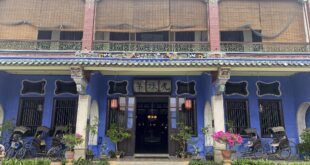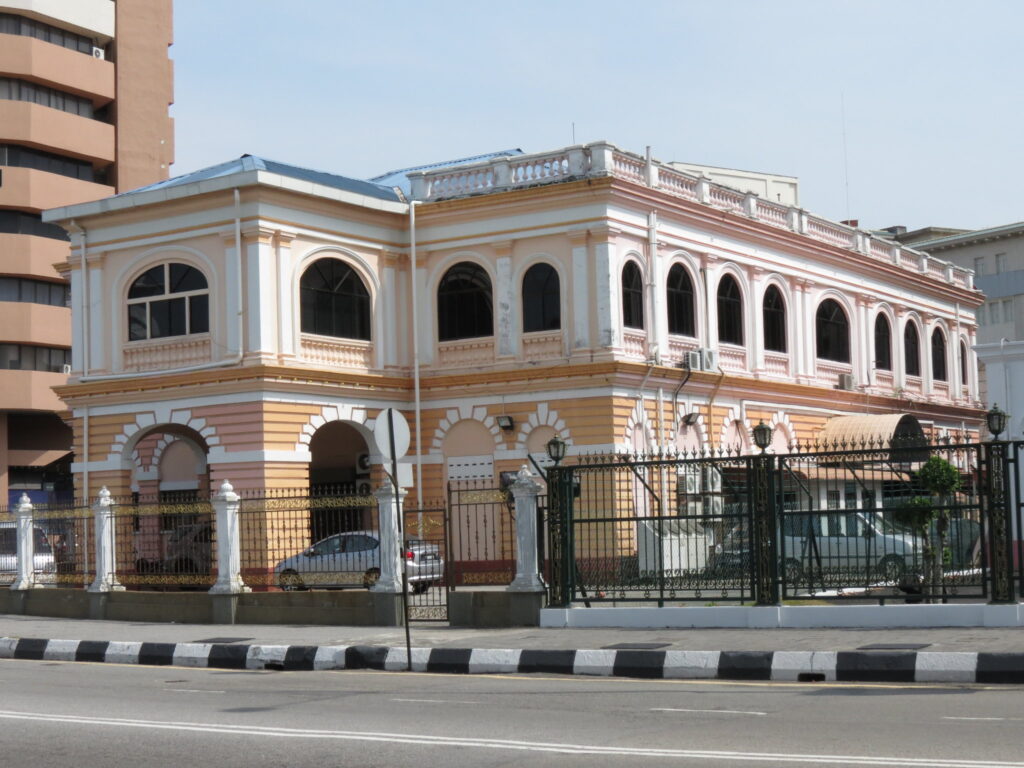
The Immigration Building Penang is a hidden gem steeped in history and cultural significance. Located at the iconic intersection of Beach and Light Streets, this landmark represents a fascinating chapter in Penang’s colonial past.
Known for its architectural charm and historical relevance, the building continues to draw history enthusiasts and curious travelers alike. Beyond its physical structure, the surrounding area offers a glimpse into the evolution of Penang’s role as a bustling hub of trade and culture.
Table of Contents
A Swamp Transformed Into a Colonial Precinct
Before the construction of the Immigration Building Penang, the area was a vast expanse of swampy and marshy terrain unsuitable for development. This environment posed significant challenges for the British colonial administration as it sought to establish Penang as a strategic trading hub in Southeast Asia. The lack of stable ground prevented the construction of any significant structures during the early days of the East India Company’s rule.
Determined to utilize Penang’s geographic advantages, the colonial authorities initiated large-scale land reclamation projects in the mid-19th century. The swampy terrain around what is now Beach Street and Light Street was systematically drained, and soil was brought in to fill the area. This extensive effort not only created firm ground for construction but also allowed for better urban planning to accommodate administrative and commercial activities.
By the 1880s, the newly reclaimed land had become a sought-after location, with Beach Street emerging as a key commercial district. The decision to build the Immigration Building Penang here in 1889 highlighted the strategic importance of this reclaimed land. The construction, which cost $18,570 (Straits dollars), represented a significant investment in creating a colonial administrative hub1.
Interestingly, the transformation of this area also contributed to Penang’s growth as a multicultural city. The new infrastructure attracted traders, businesses, and residents, creating a bustling economic zone. The site of the Immigration Building Penang stands as a testament to the ingenuity and determination of the colonial planners who turned an uninhabitable swamp into one of Penang’s most historically significant landmarks. It not only reflects the city’s remarkable transformation but also serves as a reminder of the challenges and innovations that shaped its early development.
Once Part of a Law Enforcement Hub
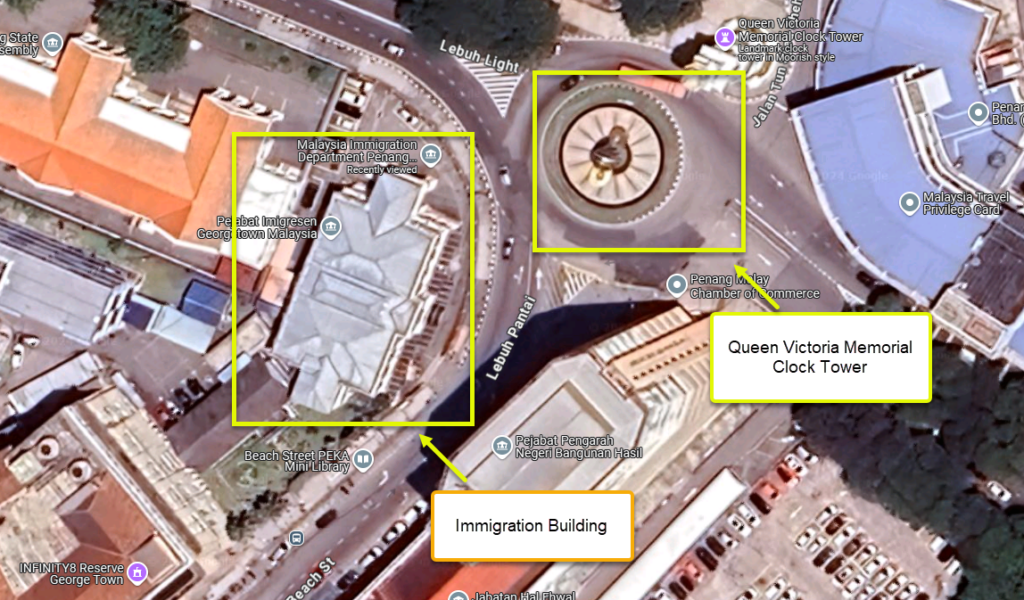
The Immigration Building Penang was not a standalone structure but an integral part of a meticulously planned colonial administrative network. When constructed in 1890, it formed a crucial segment of Penang’s law enforcement and governance precinct, reflecting the British colonial authorities’ systematic approach to maintaining order in a rapidly growing trade hub.
This building initially served as police offices and was strategically placed near other essential institutions, such as the Magistrate’s Court on Light Street and the Central Police Station2, which was later replaced by the Standard Chartered Bank building. This clustering of key administrative and judicial facilities ensured seamless communication and coordination among law enforcement, judiciary, and civic administrators.
The strategic placement of the Immigration Building Penang also played a psychological role in reinforcing colonial authority. Its proximity to Beach Street, a bustling commercial district, symbolized the British government’s visible control over Penang’s economic and civic activities. Traders, merchants, and residents were constantly reminded of the organized infrastructure and the enforcement of colonial law and order.
What sets this building apart is its ability to adapt to changing administrative roles while maintaining its historical significance. Unlike its counterparts in the precinct, such as the Central Police Station, which was later demolished, the Immigration Building Penang has survived and evolved to serve modern administrative purposes. This resilience underscores its importance as a cornerstone of Penang’s colonial governance and its transition into a modern, multicultural city.
The building stands as a testament to the strategic vision of colonial planners who understood the importance of clustering civic and legal institutions. It highlights the deliberate organization of infrastructure that ensured Penang’s transformation into a well-regulated and thriving urban center during the British colonial era. This legacy continues to resonate, making the Immigration Building Penang a unique and enduring symbol of colonial administrative ingenuity.
A Street With a Unique Name
The stretch of Beach Street between the Queen Victoria Memorial Clock Tower and Chulia Street is more than just a road—it is a narrative of Penang’s multicultural commercial evolution. Known locally by the Chinese community as European Commercial Street Penang, or “Ang Mo Tho Koh Kay,” the name itself reveals rich cultural and economic history.
During the early days of British colonial rule, this street was synonymous with European dominance in trade and commerce. It was lined with banks, trading houses, and businesses established by European merchants, serving as the economic artery of Penang under the East India Company. The name “Ang Mo Tho Koh Kay,” translating to “European Commercial Street,” became a colloquial term reflecting the area’s prominent foreign presence.
However, as Penang’s economy grown, the ownership and operation of businesses on this street began to shift. By the early 20th century, wealthy Chinese merchants had taken over much of the precinct, demonstrating the resilience and entrepreneurial spirit of the local community. These merchants not only continued the trade legacy of the street but also infused it with their unique cultural influences.
This transformation highlights the multicultural essence of Penang, where diverse communities thrived alongside one another. The mix of European architectural styles with Chinese business practices created a vibrant commercial hub that became a model of coexistence and economic dynamism.
Beach Street still retains its historical charm with many of its colonial-era buildings standing as a testament to this unique fusion of cultures. Walking along this street, one can still sense the echoes of its past—where the worlds of East and West collided to create a thriving center of commerce and culture. The name European Commercial Street Penang is more than just a title where it is a reminder of the street’s role as a bridge between Penang’s colonial history and its rich multicultural identity.
A Blend of Colonial Architecture and Local Influence
The building is a an example of British colonial architecture that blend Western design principles with the practicalities of the local environment. Constructed during the late 19th century, the building reflects the British emphasis on functional design while subtly incorporating features that cater to Penang’s tropical climate and cultural context.
Key architectural elements such as large arched windows and high ceilings served not only to add elegance but also to improve ventilation and natural lighting. These features were crucial in adapting the building to Penang’s humid and hot conditions, ensuring that the structure was both durable and practical for its administrative use. Additionally, the symmetrical design and detailed keystones on the arches highlight the British penchant for orderly, aesthetically pleasing structures.
What makes the building unique is how its design harmonizes with the surrounding landscape. Unlike purely Western designs, its muted pastel hues and the use of locally sourced materials allowed it to blend seamlessly with the multicultural and historical character of Beach Street, a bustling hub during the colonial period.
Over the years, the architectural style has influenced many other Penang historic buildings. Its design principles became a template for colonial administrative structures, setting a standard for elegance and functionality. While many buildings focused on grandiosity, the Immigration Building prioritized practicality, showcasing the British administration’s intent to create enduring infrastructure rather than merely imposing their presence.
This architectural blend continues to charm visitors, serving as a reminder of Penang’s colonial past while seamlessly integrating into its modern identity. The Immigration Building Penang stands not only as a piece of history but also as an inspiration for how design can respect and adapt to its local environment, preserving the essence of a bygone era while remaining relevant to contemporary times. This balance between colonial grandeur and local sensibility has made it a cherished landmark within Penang’s UNESCO World Heritage Site.
A Witness to Penang’s Evolution
Over the decades, as Penang transitioned from a colonial trading hub to an independent and thriving Malaysian state, the Immigration Building Penang evolved alongside the city. During its early years, it symbolized authority and order, housing police offices and serving as a linchpin in the administration of justice. Its proximity to key institutions like the Magistrate’s Court and Central Police Station highlighted its role in the broader law enforcement ecosystem.
Post-independence, the building seamlessly adapted to the needs of a modern nation, becoming a local branch of the Immigration Department. This transformation underscores the building’s ability to stay relevant amidst changing political, social, and economic landscapes. Unlike many other colonial structures that fell into disuse or were demolished, the Immigration Building Penang remained functional, proving that heritage can coexist with progress.
The building’s enduring presence is a testament to Penang’s philosophy of preserving its rich architectural legacy. It represents a bridge between the past and the present, showcasing how historical structures can be repurposed for contemporary use without losing their historical essence. The commitment to maintain and utilize this iconic structure reflects Penang’s broader approach to safeguarding its UNESCO World Heritage Site status.
It now stands not just as a relic of colonial history but as a dynamic part of the city’s administrative framework. Its ability to adapt while retaining its historical charm makes it a symbol of resilience and continuity. Whether viewed by locals who rely on its services or visitors exploring Penang’s historic streets, the building remains a powerful reminder of the city’s evolution from a colonial port to a vibrant cultural and economic hub.
A Building That Bridges the Past and Present
While it fulfills a vital administrative role in contemporary Penang as a branch of the Immigration Department, the building also serves as a gateway to the city’s storied colonial past. Its architecture, historical significance, and continued relevance highlight how Penang has managed to honor its heritage while embracing progress.
Unlike many colonial-era structures that have been converted into museums or luxury hotels, the Immigration Building Penang remains used, underscoring its adaptability and enduring importance. This continuity bridges two distinct eras:
- The days when it formed part of a colonial precinct tasked with maintaining law and order.
- In the present, where it supports a thriving multicultural society as part of the nation’s administrative framework.
What sets this building apart among Penang historic buildings is its ability to tell a story without the need for dramatic transformations. Its original purpose as police offices evolved into immigration services without losing its architectural identity. The arched windows, rusticated façade, and symmetrical design are not just aesthetic elements, they embody the practical ingenuity of colonial architects who built structures meant to last.
For visitors, the Immigration Building Penang offers more than just a visual representation of the past. It is a physical reminder of Penang’s resilience and ability to adapt. Nestled in the heart of George Town, surrounded by other colonial landmarks such as the Queen Victoria Memorial Clock Tower and Fort Cornwallis, it is a focal point for those exploring the layers of Penang’s history.
This building is also a symbol of Penang’s multicultural influences, standing in an area where European, Chinese, Indian, and Malay cultures have intersected for centuries. Its survival and active use highlight Penang’s commitment to preserving not just physical structures but also the stories they carry.
Whether you’re a local resident appreciating its enduring functionality or a tourist delving into the city’s past, the Immigration Building Penang offers a unique glimpse into the harmonious coexistence of history and modernity. It is more than just a building; it is a living chapter of Penang’s journey from a colonial trading post to a modern cultural hub, ensuring that the past continues to inspire and inform the present.
Why Visit the Immigration Building Penang?
Visiting the Immigration Building Penang isn’t just about admiring its architecture, it’s about stepping into a chapter of Penang’s history. Take a walk along Beach Street, delve into the stories of European Commercial Street Penang, and immerse yourself in the city’s colonial heritage.
This area is not only a visual treat but also a gateway to understanding Penang’s rich cultural history.
Final Thoughts
The building is more than just a historical structure, it’s a symbol of Penang’s transformation from a swampy outpost to a vibrant cultural and economic hub. Exploring this landmark and its surrounding streets is a journey through time, offering insights into Penang’s colonial history, architectural legacy, and multicultural identity. Make it a must-visit on your next trip to uncover the fascinating stories this building has to tell.
The Remarkable Transformation Of Penang Immigration Building Through Time
Late 1880s – Visionary Planning
- The British colonial government envisioned a key administrative building in George Town to support law enforcement and governance.
- The land, initially swampy, was drained and filled to prepare it for construction.
1889 – Construction Begins
- Groundbreaking marked the start of building a practical structure with imitation rustication, keystoned arches, and a north-facing porte-cochère.
- The design reflected a focus on functionality and durability for its role in law enforcement.
1890 – A Milestone Completion
- Construction was completed at a cost of $18,570 (Straits dollars).
- The building became part of a law enforcement precinct alongside the Magistrate’s Court and Central Police Station.
Early 1900s – A Colonial Powerhouse
- The building operated as a police office, integral to the colonial administration that governed Penang, a bustling trading hub.
1940s – Challenges Of War
- During World War II and the Japanese occupation, the building adapted to changing political and administrative demands.
1957 – A New Era For Independence
- Following Malaysia’s independence, the building transitioned to government use under the new Malayan administration.
1970s – New Purpose For A Legacy
- The building was repurposed as a local branch of Malaysia’s Immigration Department, cementing its administrative relevance.
2008 – Recognition Of Global Significance
- As part of George Town’s UNESCO World Heritage Site, the building was celebrated for its historical and architectural importance.
Today – A Timeless Icon
- The Penang Immigration Building continues to serve as a government office, embodying the resilience and transformation of Penang’s colonial past.
- Its enduring presence draws history enthusiasts and heritage tourists, showcasing its remarkable journey through time.
FAQ
What are the visiting hours ?
The building currently operates as a government office, so it is not open for public tours. However, visitors can view the building’s colonial architecture from the outside during regular daytime hours.
When is the best time to visit the Immigration Building?
The best time to visit is during the morning or late afternoon, as the lighting is ideal for photography, and the surrounding area is less crowded.
Is there an entrance fee for the Immigration Building?
There is no entrance fee, as the building is not accessible to the public for tours. Viewing and photographing the exterior is free.
Nearby Attractions to Explore
Here are a few nearby attractions around the Penang Immigration Building to explore:
Pinang Peranakan Mansion
A beautifully restored heritage mansion showcasing the opulent lifestyle of the Peranakans (Straits Chinese). It’s a great place to explore antiques, intricate architecture, and cultural artifacts.
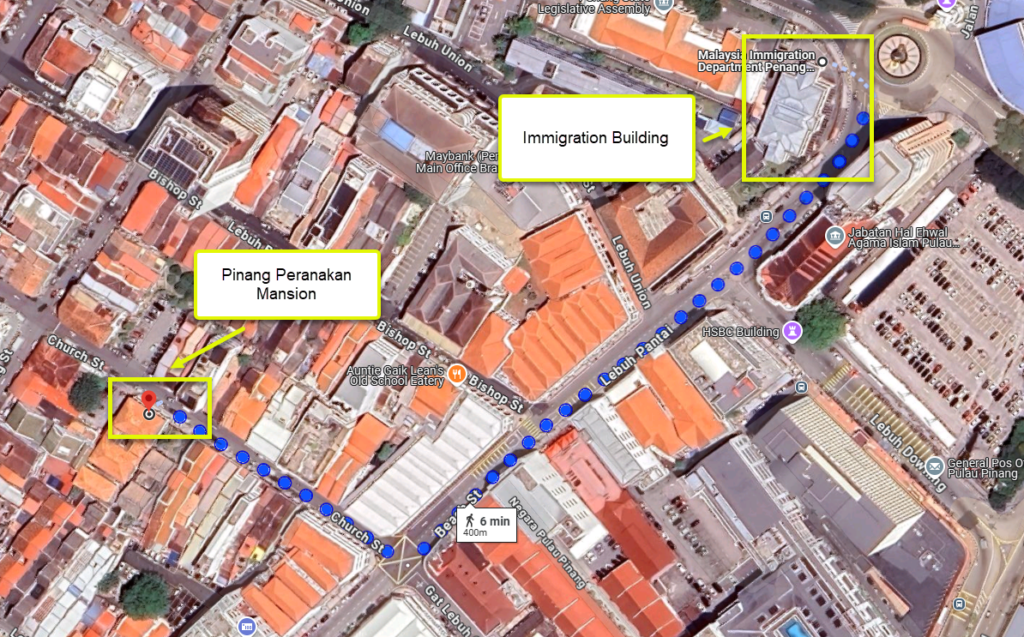
Fort Cornwallis
One of the most famous historical landmarks in Penang, this fort was built by the British East India Company in the late 18th century. Visitors can explore the preserved structure, cannons, and a lighthouse.
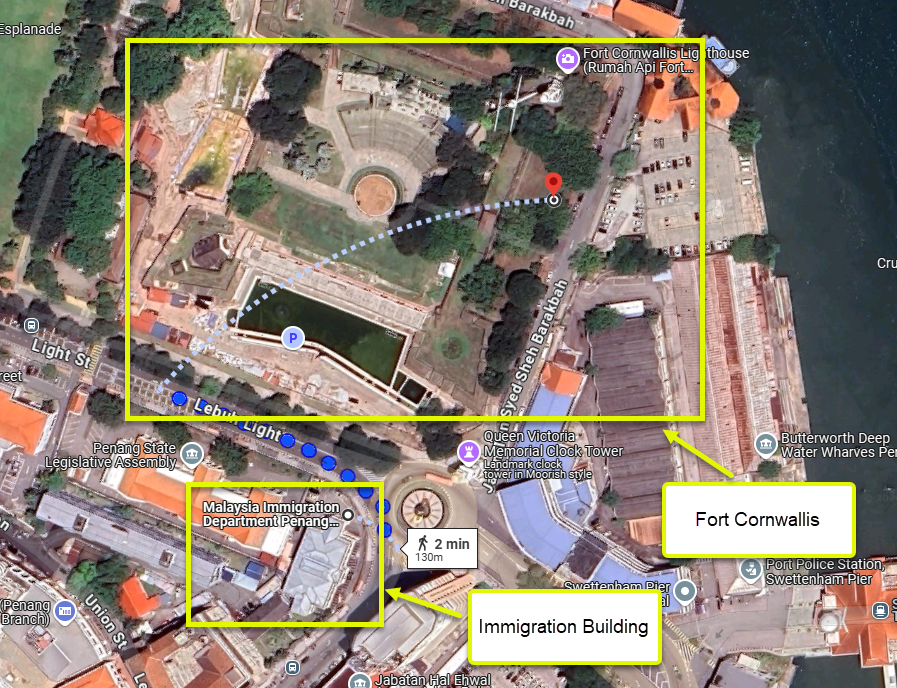
Penang Esplanade (Padang Kota Lama)
A popular waterfront promenade perfect for leisurely walks and enjoying the sea breeze. The Esplanade also hosts cultural events and festivals throughout the year.
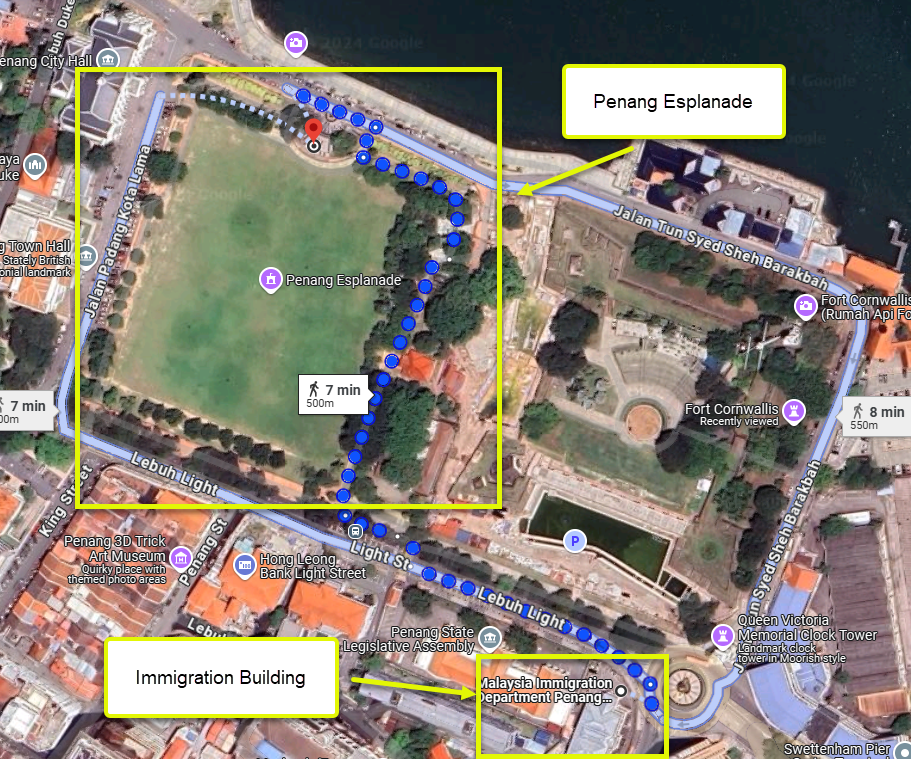
Goddess of Mercy Temple (Kuan Yin Teng)
One of the oldest Chinese temples in Penang, it’s a serene place to witness traditional Chinese architecture and cultural practices.
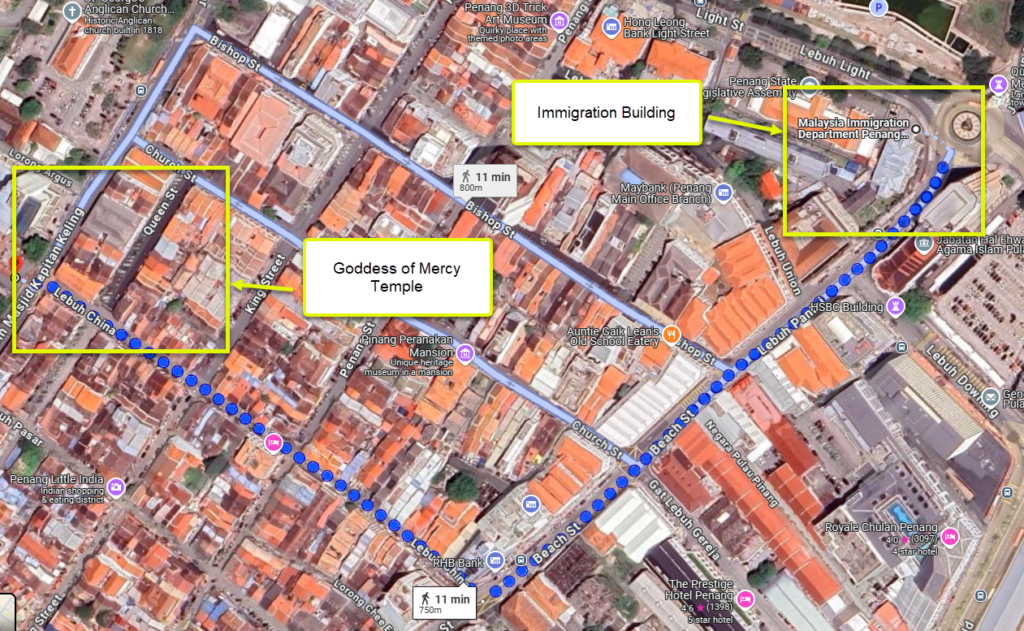
Cheong Fatt Tze Mansion (The Blue Mansion)
This iconic indigo-blue heritage mansion offers guided tours that delve into the story of Cheong Fatt Tze, a prominent figure in Penang’s history. Its architecture is a mix of Chinese and European influences.
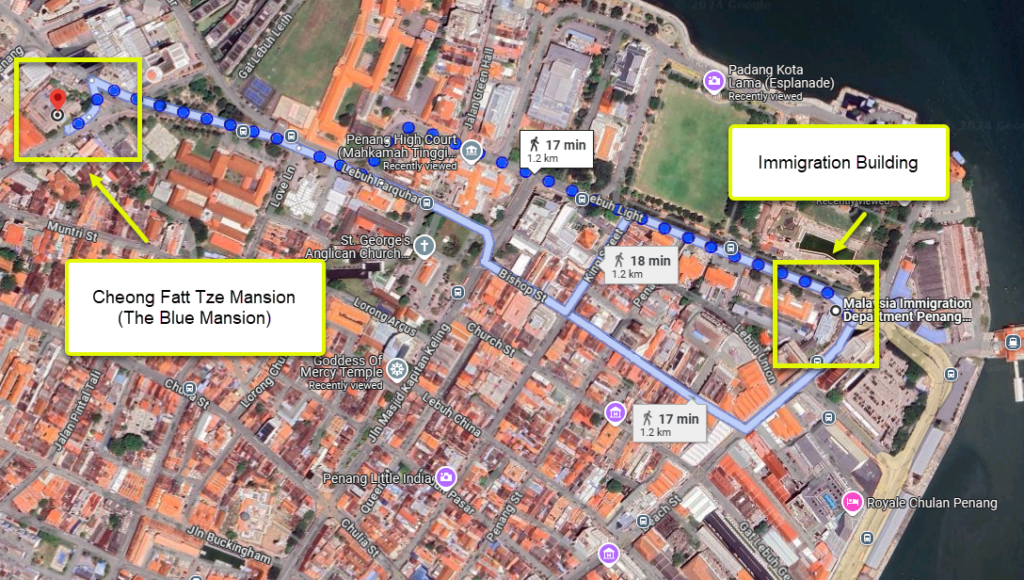
Street Art at Armenian Street
Discover Penang’s world-renowned street art, including murals and steel rod sculptures. The vibrant art scene is a must-see for those looking for something modern and creative.
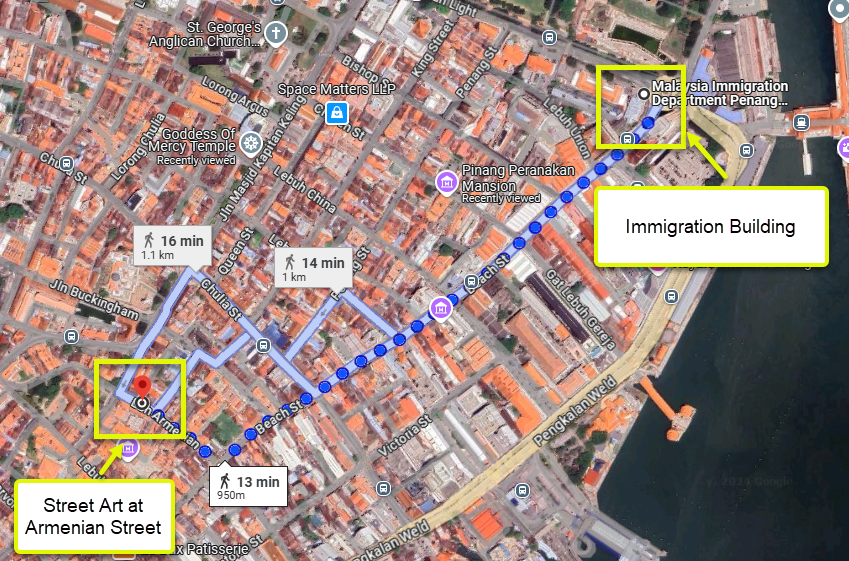
Little India
A colorful and lively district filled with shops, Indian eateries, and cultural landmarks. It’s a fantastic spot to experience Penang’s multicultural heritage.
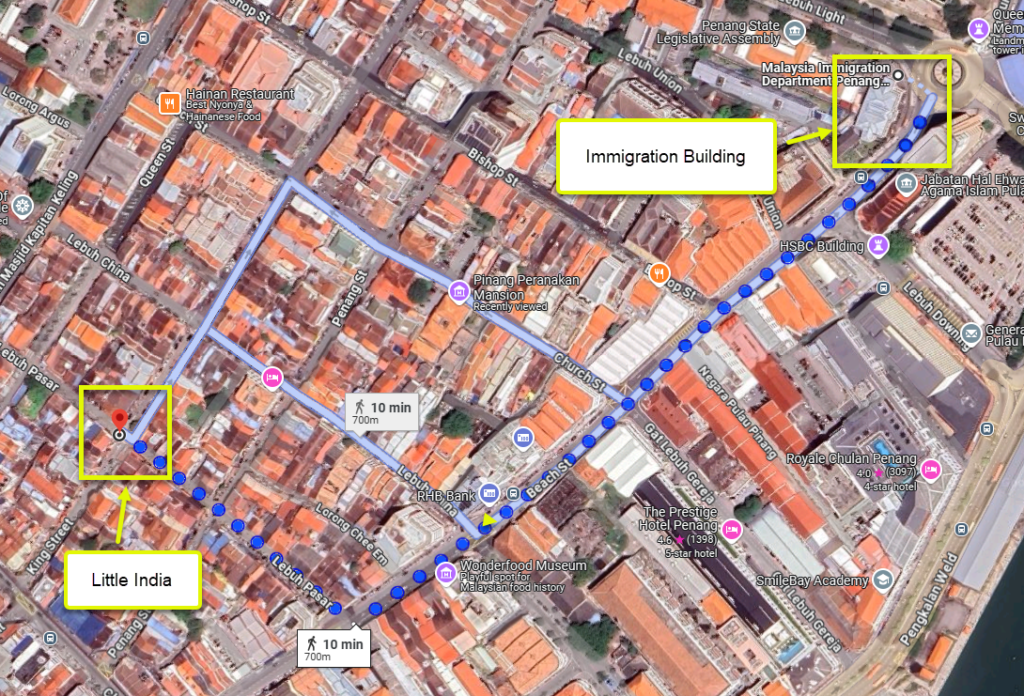
Khoo Kongsi Clan House
A stunning Chinese clanhouse known for its intricate carvings, artwork, and rich history. It’s one of Penang’s most celebrated cultural landmarks.
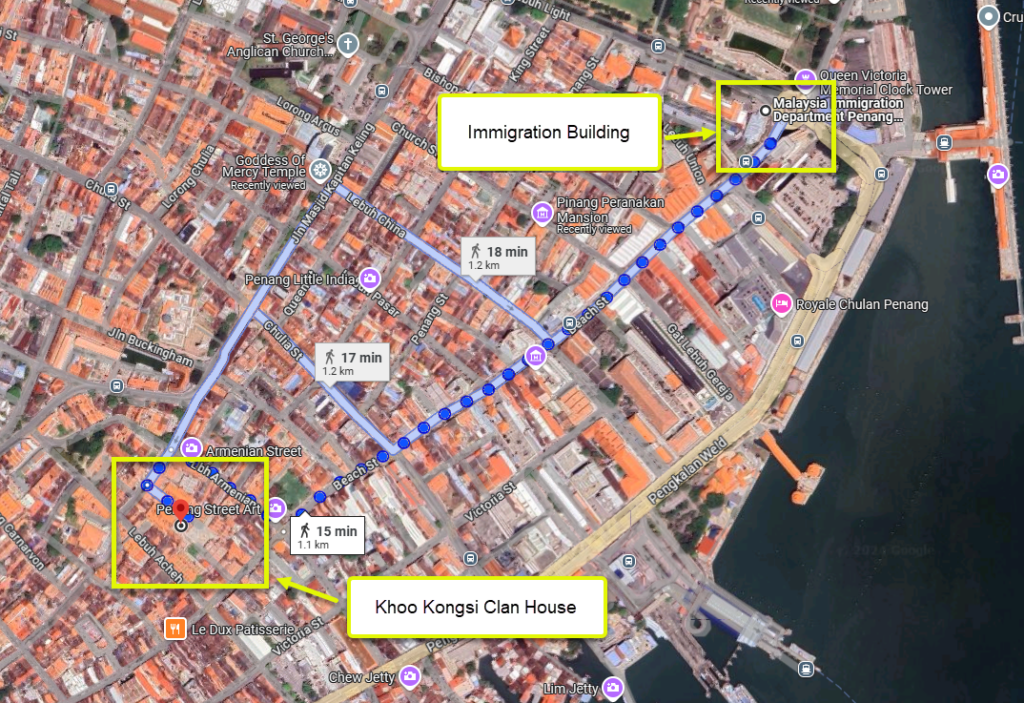
Logan Memorial
A historic obelisk located near Fort Cornwallis, built in honor of James Richardson Logan, who played a key role in promoting Penang’s legal reforms.
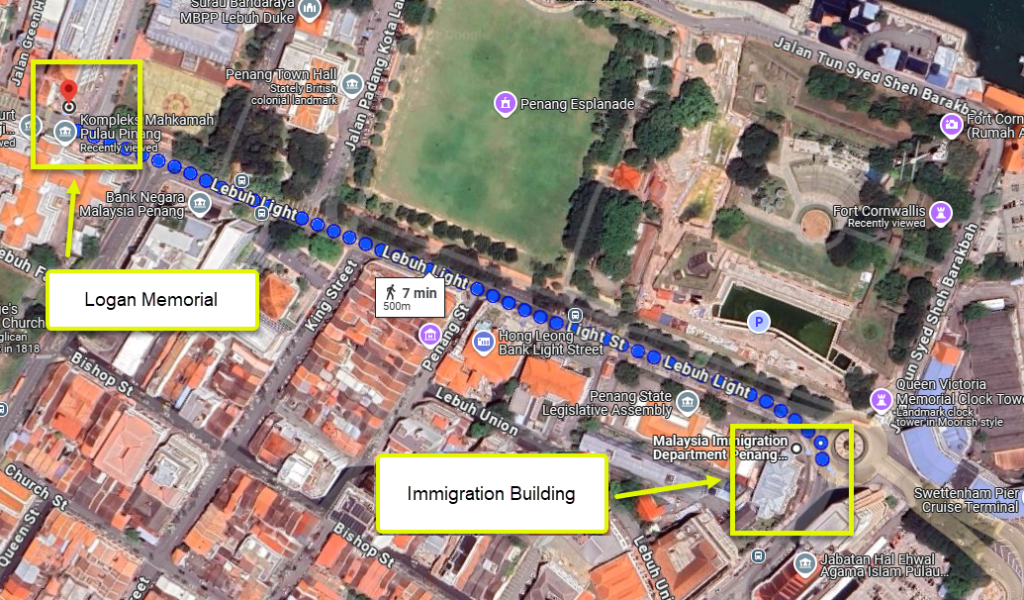
References
- Marcus Langdon, “Immigration Building – Corner of Beach & Light Streets”, George Town’s Historic Commercial & Civil Precints, 2015 ↩︎
- “Immigration Department Building”, Penang Wikia, penang.fandom.com ↩︎
